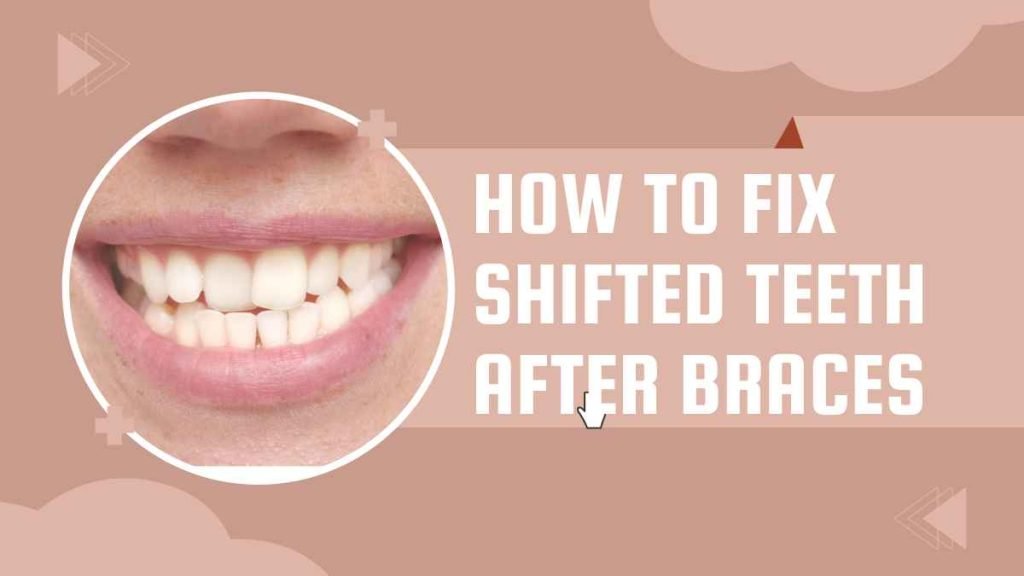How to Fix Shifted Teeth After Braces! So, you’ve just had your braces removed, expecting to flaunt that perfect smile, but alas, you notice your teeth have shifted! Don’t fret; you’re not alone. Many people experience this after braces. The good news? There are effective ways to fix shifted teeth after braces. In this comprehensive guide, we will explore How to Fix Shifted Teeth After Braces. Here we’ll explore the science behind braces, step-by-step solutions, alternative methods, reasons for teeth shifting, prevention tips, common mistakes to avoid, and intriguing facts about this dental phenomenon. Let’s dive in!
Table of Contents
How Do Braces Move Teeth?
Before understanding how to fix shifted teeth, it’s crucial to grasp how braces work. Braces use gentle, continuous pressure to shift teeth into proper alignment. They consist of brackets, wires, and rubber bands. The wires apply pressure on the brackets, guiding the teeth into desired positions over time. The process is gradual, ensuring your teeth move without damaging the roots or surrounding tissues.
How to Fix Shifted Teeth After Braces: A Step-by-Step Guide
Here you can check the step-by-step guide about How to Fix Shifted Teeth After Braces:
Total Time: 10 minutes
Consultation with an Orthodontist
The first step is crucial: consult your orthodontist. They will assess the extent of the shifting and recommend suitable treatment. This could include a retainer, clear aligners, or, in severe cases, additional braces.
Retainers: Your Best Friends
Retainers are custom-made devices that help maintain your teeth’s new position. They are typically worn at night, ensuring your teeth don’t shift while you sleep. Your orthodontist will guide you on the type of retainer best suited for you, be it removable or fixed.
Clear Aligners: Invisible Solutions
Clear aligners, like Invisalign, provide a discreet alternative. They are removable and gradually shift your teeth back into place. Regular check-ups with your orthodontist are essential to monitor progress.
Braces Round Two: A Possible Solution
In more complex cases, your orthodontist might recommend a new set of braces. This might seem daunting, but it’s a highly effective way to correct shifted teeth, ensuring they align perfectly.
Other Methods to Fix Shifting Teeth
Besides braces and retainers, there are other methods to fix shifting teeth:
Dental Bonding
Dental bonding involves applying a tooth-colored resin to reshape the shifted tooth. It’s a quick, painless procedure, ideal for minor misalignments.
Veneers: Instant Transformation
Porcelain veneers are custom-made shells placed on the front of teeth, masking imperfections and aligning them aesthetically. While pricier, they provide a swift solution for shifted teeth.
Dental Crowns: Restoring Shape
For severely shifted teeth, dental crowns can restore their shape and alignment. The process involves filing down the tooth and placing a customized crown over it, ensuring a natural look.

Why Do Teeth Shift After Braces?
Understanding why teeth shift post-braces is vital to prevent recurrence. Several factors contribute to this phenomenon:
Age and Growth: Teeth shifting can occur as you age, even after braces. Changes in facial structure or jaw alignment can lead to subtle shifts. Regular dental check-ups can catch these shifts early.
Neglecting Retainers: Wearing retainers as prescribed is crucial. Neglecting them allows teeth to revert to their original position. Consistency is key to maintaining that beautiful smile.
Wisdom Teeth: The eruption of wisdom teeth can exert pressure, causing neighboring teeth to shift. Regular dental visits can monitor the growth of wisdom teeth and prevent significant shifts.
How Fast Do Teeth Shift After Braces?
The speed at which teeth shift after braces varies from person to person. It depends on the individual’s age, oral hygiene, and adherence to post-braces care. Minor shifts might occur within a few months, while significant changes might take a couple of years. Patience and consistent oral care are essential during this period.
How to Prevent Your Teeth from Shifting After Braces
Prevention is better than cure, especially when it comes to maintaining that perfect smile. Here are some effective ways to prevent teeth from shifting after braces:
Wear Your Retainer
As mentioned earlier, retainers are your best friends. Wear them diligently as prescribed by your orthodontist, ensuring your teeth stay in their new position.
Maintain Good Oral Hygiene
Regular brushing, flossing, and dental check-ups are crucial. Good oral hygiene not only maintains your overall dental health but also prevents unexpected shifts.
Be Mindful of Habits
Avoid habits like nail-biting, pen-chewing, or using your teeth as tools. These habits can exert pressure on your teeth, leading to shifting.
Common Mistakes to Avoid
In the quest for a perfect smile, avoid these common mistakes that can cause teeth to shift:
Neglecting Follow-up Appointments: After braces, follow-up appointments are vital. They allow your orthodontist to monitor your progress and take corrective actions if necessary.
Skipping Retainer Wear: Skipping retainer wear, especially after the initial prescribed period, can lead to relapse. Consistency is key; wear your retainer as advised.
Poor Oral Hygiene: Neglecting oral hygiene can lead to gum diseases, which, in turn, can cause teeth to shift. Regular brushing, flossing, and professional cleanings are essential.
Tips and Tricks for Maintaining Your Smile
Maintaining your post-braces smile involves some handy tips and tricks:
Retainer Care: Clean your retainer regularly to prevent bacteria buildup. Soak it in a retainer-cleaning solution as per your orthodontist’s recommendation.
Avoid Teeth-staining Foods: Certain foods and beverages can stain your teeth. Limit your intake of coffee, tea, red wine, and colored foods to maintain your smile’s brightness.
Regular Dental Check-ups: Schedule regular dental check-ups to catch any subtle shifts early. Your dentist can suggest preventive measures if they notice minor changes.
Facts About Shifting Teeth After Braces
Let’s unravel some fascinating facts about teeth shifting:
Teeth Can Shift Naturally: Even without braces, teeth can shift naturally over time due to various factors. Regular dental visits can help monitor these shifts.
Genetics Play a Role: Genetics influence the size of your jaw and teeth. If your parents experienced shifting teeth, you might be predisposed to the same.
Emotional Impact: Shifted teeth can impact self-confidence. Addressing these changes promptly not only restores your smile but also boosts your self-esteem.
Conclusion
In conclusion of How to Fix Shifted Teeth After Braces, shifted teeth after braces are a common occurrence, but they are not irreversible. With the right guidance from your orthodontist and consistent oral care, you can maintain that perfect smile you’ve always desired. Remember, it’s not just about the appearance; it’s about your confidence and overall well-being. Embrace the journey to a beautiful smile, and don’t hesitate to seek professional help if needed. Your dream smile is just a step away! Here you can checkout that How to Fix Missing Teeth.
FAQs About How to Fix Shifted Teeth After Braces
Can teeth shift even if I wear my retainer regularly?
Yes, teeth can still shift, albeit minimally, even with regular retainer wear. This is why it’s crucial to attend follow-up appointments with your orthodontist to monitor any changes and take preventive measures.
Can I get braces again if my teeth have shifted significantly?
Yes, getting braces again is a viable option for correcting significant shifts. Your orthodontist will assess your teeth and recommend the most suitable treatment plan tailored to your needs.
How long do I need to wear my retainer after braces are removed?
The duration of retainer wear varies from person to person. Initially, it’s typically full-time (except when eating) and then transitioned to nights only. Your orthodontist will provide specific guidelines based on your progress.
Are there any exercises to prevent teeth shifting naturally?
While there are no specific exercises to prevent natural teeth shifting, maintaining good oral hygiene and regular dental check-ups can help monitor changes and address them promptly.
Can wisdom teeth cause significant teeth shifting?
Yes, the eruption of wisdom teeth can exert pressure on adjacent teeth, causing them to shift. Regular dental visits can monitor wisdom teeth growth and address any potential issues.
Are clear aligners as effective as traditional braces for fixing shifted teeth?
Clear aligners, like Invisalign, are effective for minor to moderate teeth shifts. However, severe cases might still require traditional braces for optimal results. Consultation with an orthodontist can determine the best option for you.
Is it common for teeth to shift after braces, even with proper care?
Yes, it is common for teeth to shift slightly even with proper care. This is why wearing retainers as advised and attending regular dental check-ups are essential to address any subtle changes promptly.


